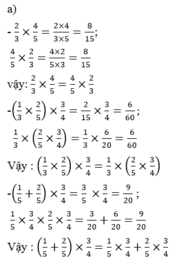Hãy nhập câu hỏi của bạn vào đây, nếu là tài khoản VIP, bạn sẽ được ưu tiên trả lời.


We can choose our friends, but we cannot choose our relatives. That does not mean that members of our family cannot also be our friends. Many children have a very good relationship with their parents and they see them as friends. Of course when you are teenager, there are time that you do not get on very well with their parents, or they can get angry with you. That only natural. There are times you want to be independent and decide things by yourself. After that, nobody perfect and we all make mistakes. But your parents understand that. When you grown up, ou will see that you have many things in common with your mum and dad and you will be closer to them.

a)
| x-3 | 1 | -1 | 7 | -7 |
| 2y +1 | 7 | -7 | 1 | -1 |
| x | 4 | 2 | 10 | -4 |
| y | 3 | -4 | 0 | -1 |
b)
| 2x +1 | 1 | -1 | 5 | -5 | 11 | -11 | 55 | -55 |
| 3y-2 | -55 | 55 | -11 | 11 | -5 | 5 | -1 | 1 |
| x | 0 | -1 | 2 | -3 | 5 | -6 | 27 | -28 |
| y | / | 19 | -3 | / | -1 | / | / | 1 |
Có 4 đáp số :(x =-1; y =19) ; (x =2 ; y =-3)
(x =5 ; y =-1) ; (x =-28 ; y =1)
a,(x-3)(2y+1)=7
Ta co: 7=1.7=7.1=(-1).(-7)=(-7).(-1)
\(\Rightarrow\)(x-3)(2y+1)=1.7 hay (x-3)(2y+1)=7.1 hay (x-3)(2y+1)=(-1).(-7) hay (x-3)(2y+1)=(-7).(-1)
TH1: \(\text{(x-3)(2y+1)=}1.7\Rightarrow\orbr{\begin{cases}\left(x-3\right)=1\\\left(2y+1\right)=7\end{cases}\Rightarrow\orbr{\begin{cases}x=4\\y=3\end{cases}}\left(TM\right)}\)
TH2: \(\text{(x-3)(2y+1)=7.1}\Rightarrow\orbr{\begin{cases}\text{(x-3)=7}\\\text{ }\text{(2y+1)=1}\end{cases}\Rightarrow\orbr{\begin{cases}x=10\\y=0\end{cases}}\left(TM\right)}\)
TH3:\(\text{(x-3)(2y+1)=(-1).(-7)}\Rightarrow\orbr{\begin{cases}\text{(x-3)=-1}\\\text{(2y+1)=-7}\end{cases}\Rightarrow\orbr{\begin{cases}x=4\\y=-8\end{cases}\left(TM\right)}}\)
TH4: \(\text{(x-3)(2y+1)=(-7).(-1)}\Rightarrow\orbr{\begin{cases}\text{(x-3)=-7}\\\text{(2y+1)=-1}\end{cases}\Rightarrow\orbr{\begin{cases}x=-4\\y=-1\end{cases}\left(TM\right)}}\)
Vay (x,y)={(4,3);(10,0);(4,-8);(-4;-1)}
b, (2x+1)(3y-2)=-55
Ta co: -55=-1.55=1.(-55)=55.(-1)=-55.1=-11.5=11.(-5)=5.(-11)=-5.11
\(\Rightarrow\)(2x+1)(3y-2)=-1.55 hay (2x+1)(3y-2)=1.(-55) hay (2x+1)(3y-2)=55.(-1) hay (2x+1)(3y-2)=-55.1 hay (2x+1)(3y-2)=-11.5
hay (2x+1)(3y-2)=11.(-5) hay (2x+1)(3y-2)=5.(-11) hay (2x+1)(3y-2)=-5.11
TH1:\(\text{(2x+1)(3y-2)=-1.55}\Rightarrow\orbr{\begin{cases}\text{(2x+1)=-1}\\\text{(3y-2)=55}\end{cases}\Rightarrow\orbr{\begin{cases}x=-1\\y=19\end{cases}\left(TM\right)}}\)
TH2:\(\text{(2x+1)(3y-2)=1.(-55)}\Rightarrow\orbr{\begin{cases}\text{(2x+1)=1}\\\text{(3y-2)=-55}\end{cases}\Rightarrow\orbr{\begin{cases}x=0\\y=\frac{-53}{3}\end{cases}\Rightarrow}\left(loai\right)}\)
TH3:\(\text{(2x+1)(3y-2)=55.(-1)}\Rightarrow\orbr{\begin{cases}\text{(2x+1)=55}\\\text{(3y-2)=-1}\end{cases}\Rightarrow\orbr{\begin{cases}x=27\\y=\frac{1}{3}\end{cases}\left(loai\right)}}\)
TH4: \(\text{(2x+1)(3y-2)=-55.1}\Rightarrow\orbr{\begin{cases}\text{(2x+1)=-55}\\\text{(3y-2)=1}\end{cases}\Rightarrow\orbr{\begin{cases}x=-28\\y=1\end{cases}\left(TM\right)}}\)
TH5: \(\text{(2x+1)(3y-2)=-11.5}\Rightarrow\orbr{\begin{cases}\text{(2x+1)=-11}\\\text{(3y-2)=5}\end{cases}\Rightarrow\orbr{\begin{cases}x=-6\\y=\frac{7}{3}\end{cases}\left(loai\right)}}\)
TH6: \(\text{(2x+1)(3y-2)=11.(-5)}\Rightarrow\orbr{\begin{cases}\text{(2x+1)=11}\\\text{(3y-2)=-5}\end{cases}\Rightarrow\orbr{\begin{cases}x=5\\y=-1\end{cases}\left(TM\right)}}\)
TH7:\(\text{(2x+1)(3y-2)=5.(-11)}\Rightarrow\orbr{\begin{cases}\text{(2x+1)=5}\\\text{(3y-2)=-11}\end{cases}\Rightarrow\orbr{\begin{cases}x=4\\y=-3\end{cases}\left(TM\right)}}\)
TH8:\(\text{(2x+1)(3y-2)=-5.11}\Rightarrow\orbr{\begin{cases}\text{(2x+1)=-5}\\\text{(3y-2)=11}\end{cases}\Rightarrow\orbr{\begin{cases}x=-3\\y=\frac{13}{3}\end{cases}\left(loai\right)}}\)

â) Ta có : \(2n-1⋮n+1\Leftrightarrow2n+2-2-1⋮n+1\)
\(\Leftrightarrow2\left(n+1\right)-2-1⋮n+1\)\(\Leftrightarrow2\left(n+1\right)-3⋮n+1\)
\(\Leftrightarrow2n-1⋮n+1\)khi \(3⋮n+1\Rightarrow n+1\in\)Ước của \(3\) \
\(\Leftrightarrow n+1\in\left(1;-1;3;-3\right)\)
\(\Leftrightarrow n\in\left(0;-2;2;-4\right)\)
Vậy \(n\in\left(-4;-2;0;2\right)\)
b) Ta có :\(9n+5⋮3n-2\Rightarrow3\left(3n-2\right)+6+5⋮3n-2\)
\(\Rightarrow3\left(3n-2\right)+11⋮3n-2\)
\(\Rightarrow9n+5⋮3n-2\)Khi \(11⋮3n-2\)
\(\Rightarrow3n-2\in U\left(11\right)\)
\(\Rightarrow3n-2\in\left(-11;-1;1;11\right)\)
\(\Rightarrow n\in\left(-3;1;\right)\)
Phần c) bạn tự làm nhé!

Tiếng anh
if the number you are a male and female friends is b.
Each male has a-1 male (except your own), and b girls. Accordingto the a-1 = b.
Each girl has a male and female friends b-1 (except the ladies outthere). According to have a = 2 (b-1).
So we have:
a - 1 = b
a = 2 (b - 1)
Deduce a = 4, b = 3.
So your student group has 4 boys and 3 girls.
Tiếng việt
Nếu số bạn nam là a và số bạn nữ là b.
Mỗi bạn nam có a-1 bạn nam (trừ ra chính bạn đó), và b bạn nữ. Theo bài ra thì a-1 = b.
Mỗi bạn nữ có a bạn nam và b-1 bạn nữ (trừ ra chính bạn nữ đó). Theo bài ra ta có a = 2(b-1).
Vậy ta có:
a - 1 = b
a = 2(b - 1)
Suy ra a = 4, b = 3.
Vậy nhóm học sinh có 4 bạn nam và 3 bạn nữ.
Một nhóm sinh viên, bao gồm cả trẻ em trai và trẻ em gái đang rất gần, bất kỳ hai của bạn trong nhóm là những người bạn thân. Các chàng trai nói với nhau rằng mỗi chúng ta có một số kẻ với một số người bạn nữ. Andthe cô gái nói với nhau rằng mỗi chúng ta có hai lần số người bạn gái. (Lưu ý: Một số bạn bè của mỗi người trong thegroup). Đó là nhóm các sinh viên hỏi có bao nhiêu bạn nam, bao nhiêu cô gái?

đều cộng hết nha
90 >89